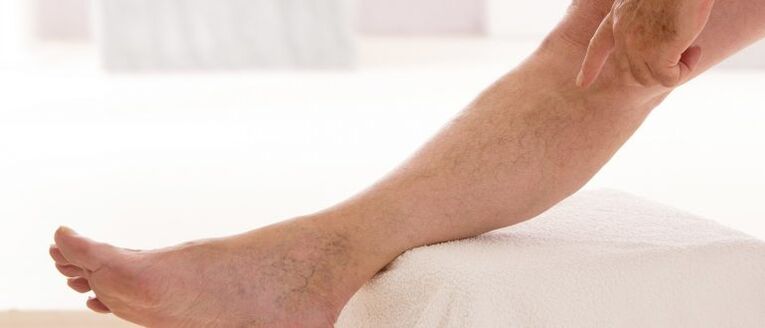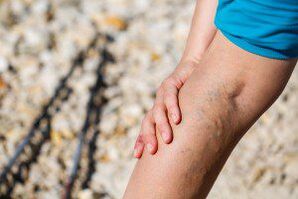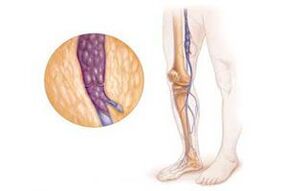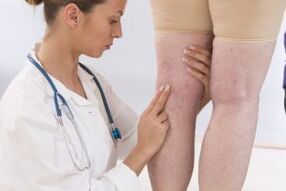
Do not remember the prevalence of vascular diseases.In summer, each time you go out, you can notice a blue caviar network in women and men.How dangerous this pathology is, probably not everyone knows.
What are the veins varicose veins
What are varicose veins?This is a disease when peripheral arteries swell.They are wrapped, tied, project above the surface of the skin.
Normal blood circulation is disturbed, the pressure occurs.
When it reaches the maximum concentration, the vessel walls are stretched.
The legs turn blue, due to the large number of protruding vessels and venous networks.
Risk factors
Factors that provoke the appearance of varicose veins include:
- take hormonal drugs, pregnancy;
- Influence of extra pounds, obesity;
- hereditary factor;
- Work in high temperatures, constantly sitting or standing.
You need to constantly monitor your way of life.Do not allow excessive leg work, great physical activity.
Perform prevention as soon as the first signs seemed.

Causes
There are two conditional subgroups: the main and secondary causes of malaise.
Primary:
- Hard physical work;
- sedentary lifestyle;
- Body weight set;
- hereditary factor;
- genetic disposition.
Secondary:
- stress and anxiety;
- Pressure in the area of arterial blood flow;
- physical training with heavy weights;
- very tight clothes, tight shoes;
- endocrine system disturbance.
The development mechanism of varicose veins
It all starts with light symptoms, it seems that simple tiredness is affecting the joints.At the end of the workday appear swelling and pains in the calves, and cramps bother me periodically.
Soon the visible manifestations to the naked eye begin to develop.First, a slight vascular network appears on the legs and then a nodularity.
The disease development mechanism must be stopped as soon as you feel the first pain.
Internships
There are 6 stages of varicose veins.They are developing quickly.If you do not treat the disease in the first stage, you may quickly end up at the operating table.
Degree – 0. The person begins to feel the full range of sensations inherent to the disease, but the examination does not give a positive result.
Degree - 1. Symptoms progress and a venous network appears in the legs.
Grade – 2. From this stage onwards the manifestation of typical varicose veins begins.Joints hurt after exertion or long periods of stagnation.The arteries swell and nodules appear.
The degree - 3. The rest is added edema, which is more pronounced at night.
Degree - 4. Trophic changes are developing.Members acquire a painful appearance, skin color changes and wounds appear.
Grade - 5. The totality of all manifestations and a healed ulcer.
Grade - 6. Trophic ulcer continues to develop actively.

Types of vascular discomfort
This classification of varicose veins is divided based on the affected body types.
There are only 4 types of them, namely:
- Reticular varicose veins.There are no complications at this stage, only small capillaries are touched.Therapy quickly eliminates this defect;
- segmental.It is considered the initial stage of varicose veins.The tax arteries are tuned;
- The trunk is called varicose veins when a large and small subcutaneous artery participates.The ducts increase, since the symptom is insufficient circulation;
- Performer.The connection veins and surface vessels under the skin expand.
The listed types of varicose veins are characteristic of different stages of development and manifestation of venous deformation.
Than the disease is dangerous in the absence of timely therapy
With this pathology, it is very important to resort to time experts.Each stage quickly enters a new one.
Having gained speed, varicose veins can cause more serious problems.
- Thrombosis.When the blood thickens, the vessels enters.Cloths are formed.The legs hurt and swell.
- Teleangiectasia.Harmony that does not decorate the legs.Vascular networks appear.And also seizures and swelling are concerned.
- Thrombophlebitis.A complex disease with characteristic symptoms.Dark skin, redness, blockage of blood vessels, blood clots.
- Trophilic ulcer.This is a consequence of a severe form of varicose veins.Blood circulation is broken, wounds open, ulcers appear.
- Bleeding.The arteries are so covered and inflated the skin that it becomes thinner and breaks down over time.Bleeding can be internal and external.
Diagnosis
Often the symptoms are bright and clearly expressed.
Do not make a diagnosis, it is better to go through an expert exam.
Patient complaints
Initially, varicose veins do not show themselves.
The most common complaints can be swollen, fatigue after jumps and seizures at night.

Clinical inspection
The appearance of the lower extremities will indicate a diagnosis.The legs are swollen, with a slight or pronounced vascular mesh.
In the last stages, ulcers are possible.
Instrumental Techniques
The doctor should be directed to ultrasound diagnosis.This method is very informative.It will show the state of blood vessels, blood flow, patency, blood clots and so on.
Laboratory techniques
Using tests, you cannot find a pathology, but it will definitely help to find out about the condition of the blood.
Excessive amount of leukocytes indicates that an inflammatory process occurs in the body.
What experts need to contact
If disturbing signs and symptoms are detected, specialists will immediately conduct diagnostics.
Which doctor is needed?
First of all, a phlebologist.The Doctor's specialization is aimed precisely at the study of vein pathologies.
Therapist.The doctor will certainly prescribe tests, according to the results he will direct you to a specific specialist, who will significantly save your time.
Vascular surgeon.Your task is simple, to identify whether the state of veins and blood vessels has changed in connection with the development of the disease.As a result, prescribe treatment or prevention.
Angiologist.Specialists in this area prefer conservative intervention.This only helps eliminate the subsequent growth of symptoms.Therefore, in heavy stages, visiting this doctor will be inappropriate.
Symptoms of pathology
Not to run The disease of incurable complications should be known to know all the symptoms that may appear during the development of this disease.
The disease of incurable complications should be known to know all the symptoms that may appear during the development of this disease.
The main features:
- the appearance of heat;
- pain and heaviness;
- At night, swelling and seizures;
- The venous mesh is brighter than usual;
- Skin seals.
Smaller resources:
- External changes only cover the area of the hole under the knee and the back of the leg;
- The affected tissues are felt;
- swelling of soft tissues and feet;
- pigmentation and compaction of the skin;
- Trophic ulcers.
There are also serious symptoms of varicose veins, which require immediate hospitalization: bleeding, rupture of nodes.
Therapy
The supposed treatment of varicose veins depends on its progression.
Patients who immediately seek medical help can do so with conservative methods.
Drug treatment
After undergoing medical diagnosis, the doctor prescribes a course of medicines necessary for the case.
After admission course, the patient should be diagnosed for the second time to ensure that there is no need to continue treatment.
In other cases, medicines are taken again.
The use of compression materials
The phlebologist individually selects special underwear, which he restores without surgical intervention.
Diet
The patient needs to eat foods that strengthen the vascular walls, avoiding blood clotting and the formation of blood clots.They contain the main component - Cumarina.
For example: currant, garlic, cherry, lemon.
Exercise therapy
Exercise is very important for this disease.
Loads activate blood circulation and flow into the lower ends.

Physiotherapy
One of the varicose vein treatment methods is physiotherapy.The procedures are selected and prescribed only by a doctor based on the individual course of the disease.
This can be a massage or laser method.
Hirudotherapy
This procedure relaxes the muscles, thin blood, normalize blood pressure and restore lymphatic drainage.
Surgery
Surgical measures are used when the patient seeks help late.
Main Surgical Methods: Flebectomy, Short Stripping, Endoscopic Vein dissection.
Prevention for varicose veins
Preventive methods for the disease are very important, especially in the initial phase of development.
Try to walk more and avoid wearing tight shoes and clothes.Do not get excited to go to the resort or sauna.
After a tiring day, you can do simple exercises that promote relaxation.
Gymnastics
Light exercises, selected by a specialist, help activate blood circulation in the legs.
There are complexes that can be done not only at home but also at work.
Traditional therapy
Sometimes popular Grandma treatment methods are no less effective.
Here are some of them:
- Indian chestnut tincture.It takes three treatment courses, each of them: for 7 days before meals, drink one tablespoon of the tincture.Then we take a 14 -day break and then continue.To do this you need to take 50 grams of plant flowers, 0.5 liter of alcohol.Pour the nuts and leave it for two weeks.
- To strengthen blood vessels, drink natural juices of fruits and vegetables every day.Regular saturation of the body with vitamins will prevent the development of the disease.
What is harmful in varicose veins
The disease described above does not like heat and huge energy loads.You cannot jump, run or exercise on a treadmill or spare tire.
Barbell lovers will also have to postpone the session to eliminate the load on the lower limbs.


















